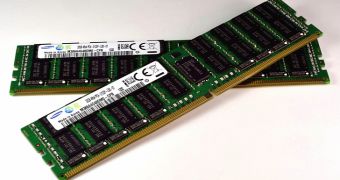DDR4 memory might not be expected to reach consumers before 2015, or maybe not even before 2016, but servers already have a processing platform with support for it, which is why companies, like Samsung in this instance, already have DDR4 memory available.
Intel and Advanced Micro Devices won't release PC central processing units and accelerated processing units (CPUs and APUs) until 2015 or 2016.
The server market already has one supporting platform though, specifically the Intel Xeon E6 2600 v3 product family.
Or, rather, the chips are almost out, since they will only be released in the second quarter of the year. Sure, that could mean anything between July and December 2014, but it's likely that they will make it out in time for IFA (September trade show that takes place in Berlin, Germany), if nothing else.
The other day, SK Hynix released a 128 GB DDR4 memory module, thereby leaving pretty much everyone else on the market in the dust.
Samsung doesn't have a 128 GB module, but it does have 64 GB DDR4, as well as smaller-capacity ones of as low as 8 GB.
The products are made from its 4 Gb chips and are already available globally. However, the company feels that supply isn't large enough.
That is why it has announced that it is stepping up production, so that server manufacturers don't have to fight too hard over who gets what shipment.
Some are already placing orders, but most are holding out until 2H14, when the Xeon processors will debut and give them a perfect idea of how much RAM they actually need, and what type. Server motherboards are also a concern.
Samsung wants to be ready for when the time comes, and it will probably be competing with the likes of Hynix over potential customers, rather than server makers trying to outbid each other in the memory acquisitions.
Samsung's modules come in RDIMM, LRDIMM and ECC SODIMM form factors, but there are x4, x8 and x16 DDR4 chips. Furthermore, 8 Gb chips will be released later in 2014, and will enable 32 GB DDR4 modules for high-density server markets.
Finally, the memory clocks are of 2133 to 2400 Mbps (MHz). For the sake of comparison, DDR3 modules work at 1066 to 1600 or 1866 MHz (in rare cases). And before you ask, no, this isn't the consumer industry where DRAM companies overclock the living lights out of RAM and manage to drive DDR3 to over 2500 MHz.

 14 DAY TRIAL //
14 DAY TRIAL //